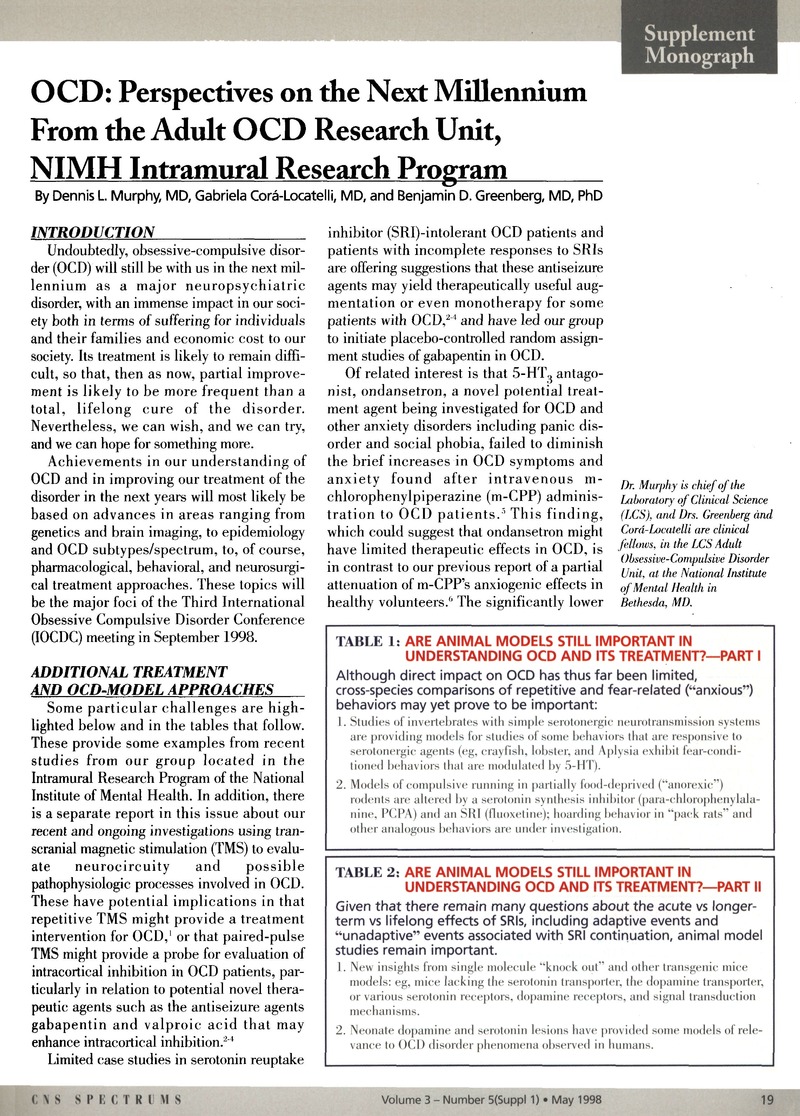No CrossRef data available.
Article contents
OCD: Perspectives on the Next Millennium From the Adult OCD Research Unit, NIMH Intramural Research Program
Published online by Cambridge University Press: 07 November 2014
Abstract
An abstract is not available for this content so a preview has been provided. Please use the Get access link above for information on how to access this content.

- Type
- Supplement Monograph
- Information
- CNS Spectrums , Volume 3 , Issue S1: New Developments in Obsessive-Compulsive and Spectrum Disorders , May 1998 , pp. 19 - 20
- Copyright
- Copyright © Cambridge University Press 1998
References
REFERENCES
1.Greenberg, BD, George, MS, Benjamin, J, et al.Effect of prefrontal repetitive transcranial magnetic stimulation in obsessive-compulsive disorder: a preliminary study. Am J Psychiatry. 1997;154:867–869.Google ScholarPubMed
2.Corá-Locatelli, G, Greenberg, BD, Martin, JD, Murphy, DL. Valproate monotherapy in SRI-intolerant OCD patient. Clin Psychiatry. 1998;59:82.CrossRefGoogle ScholarPubMed
3.Corá-Locatelli, G, Greenberg, BD, Martin, JD, Murphy, DL. Rebound psychiatric and physical symptoms after gabapentin discontinuation. J Clin Psychiatry. In press.Google Scholar
4.Corá-Locatelli, G, Greenberg, BD, Martin, J, Leong, Y-M, Murphy, DL. Gabapentin augmentation for fluoxetine-treated patients with obsessive-compulsive disorder Submitted.Google Scholar
5.Broocks, A, Pigott, TA, Hill, JL, et al.Acute administration of ondansetron and m-cpp, alone and in combination, in patients with obsessive-compulsive disorder (OCD) and controls: behavioral and biological results. Psychiatry Research. In press.Google Scholar
6.Broocks, A, Briggs, NC, Pigott, TA, et al.Behavioral, physiological, and neuroendocrine responses in healthy volunteers to m-chlorophenylpiperazine (m-CPP) with and without ondansetron pretreatment. Psychopharmacology. 1997;130:91–103.CrossRefGoogle ScholarPubMed
7.Altemus, M, Glowa, JR, Galliven, E, Leong, YM, Murphy, DL. Effects of serotonergic agents on food-restriction-induced hyperactivity. Pharmacol Biochem Behav. 1996;53:123–131.CrossRefGoogle ScholarPubMed
8.Altemus, M, Murphy, DL. Animal models of obsessive-compulsive disorder. In: Westenberg, HGM, Murphy, DL, Den Boer, JA, eds. Advances in the Neurobiology of Anxiety Disorder. New York: Wiley, 1996:249–278.Google Scholar
9.Bengel, D, Murphy, DL, Andrews, AM, et al.Altered brain serotonin (5-HT) homeostasis and locomotor insensitivity to MDMA (“ecstasy”) in 5-HT transporter-deficient mice. Molecular Pharm. 1998;53:649–655.CrossRefGoogle ScholarPubMed
10.Murphy, DL, Greenberg, B, Altemus, M, Benjamin, J, Grady, T, Pigott, T. The neuropharmacology and neurobiology of obsessive-compulsive disorder: an update on the serotonin hypothesis. In: Westenberg, HGM, Murphy, DL, Den Boer, JA, eds. Advances in Neurobiology of Anxiety. 1996;2:279–298.Google Scholar
11.Murphy, DL, Andrews, AM, Wichems, CH, Li, Q, Greenberg, B. Brain serotonin neurotransmission: an overview and update with an emphasis on serotonin subsystem heterogeneity, multiple receptors interactions with other neurotransmitter systems, and consequent implications for understanding the actions of serotonergic drugs. J Clin Psychiatry. In press.Google Scholar
12.Weiger, WA. Serotonergic modulation of behaviour: a phylogenetic overview. Biol Rev. 1996;72:61–95.CrossRefGoogle Scholar
13.Karayiorgou, M, Altemus, M, Galke, BL, et al.Genotype determining low catechol-o-methyltransferase activity as a risk factor for obsessive-compulsive disorder. Proc Natl Acad Sci USA. 1997;94:4572–4575.Google Scholar




